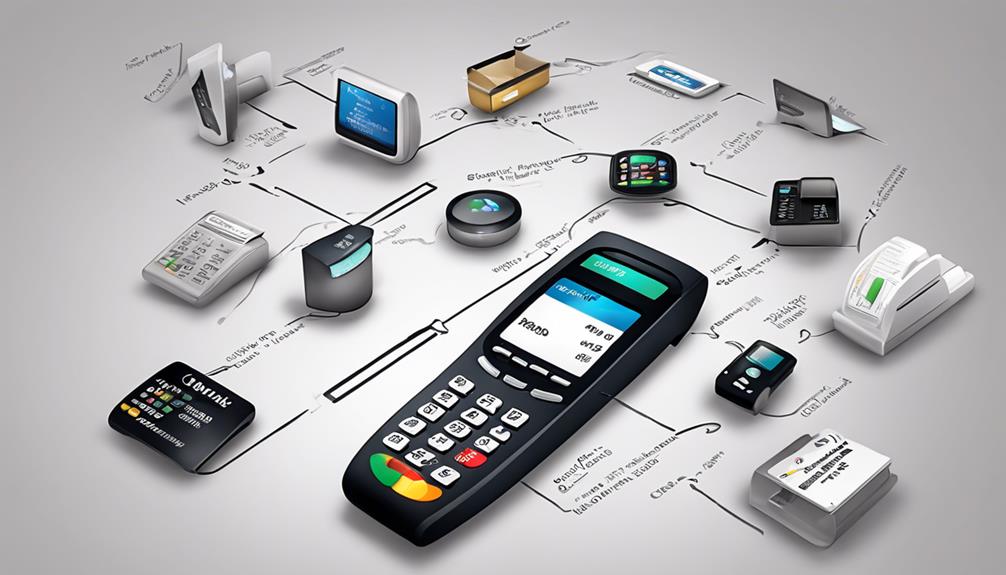Chargebacks cost you more than just lost sales—they drain your resources, increase processing fees, and risk your merchant account. Handling disputes takes time and diverts staff from serving genuine customers, which can harm your reputation and loyalty. Investing in fraud prevention and good customer service helps reduce these hidden costs and keeps your business stable. Want to understand how to protect your bottom line even further? Keep exploring for more insights.
Key Takeaways
- Chargebacks incur significant fees and increased processing costs, affecting overall profit margins.
- Handling disputes consumes valuable business resources and time, diverting focus from core operations.
- Frequent chargebacks harm merchant relationships with payment processors, risking account suspension.
- Poor dispute management damages customer trust, leading to negative reviews and loyalty loss.
- The hidden costs of fraud prevention and reputation damage can outweigh the initial transaction loss.

Have you ever wondered how much chargebacks really cost your business? It’s tempting to see them as just a refund for a disputed transaction, but their true impact runs much deeper. When a customer files a chargeback, it’s not only money lost on that sale, but also a ripple of additional costs that can strain your resources and reputation. One of the most critical aspects to consider is the importance of effective fraud prevention. If your fraud detection systems aren’t robust enough, you risk more chargebacks from fraudulent transactions, which can be costly both financially and in terms of customer trust. Investing in strong fraud prevention tools helps you catch suspicious activity early, reducing the likelihood of chargebacks and protecting your bottom line. Additionally, understanding the hidden costs of chargebacks can help you develop better strategies to mitigate their impact.
Beyond the immediate financial hit, chargebacks can severely affect your customer service efforts. Every dispute requires time and effort from your team—investigating, communicating with banks, and handling customer inquiries. This diverts valuable resources away from serving genuine customers or improving your business. Furthermore, if your customer service isn’t proactive or responsive during these disputes, you risk damaging the relationship further. Customers may feel frustrated if their concerns aren’t addressed promptly, leading to negative reviews and lost loyalty. To minimize this, you should establish clear, transparent communication channels and ensure your team is trained to handle disputes professionally and empathetically.
Chargebacks also come with fees that can add up quickly. Payment processors often impose hefty chargeback fees, which eat into your profit margins, especially if you regularly face disputes. This financial strain can hinder your ability to reinvest in your business, whether that’s upgrading technology, expanding marketing efforts, or improving product quality. Additionally, a high chargeback rate can lead to increased processing fees or even the suspension of your merchant account, which could be catastrophic for your operations.
Furthermore, frequent chargebacks can tarnish your reputation with payment processors, making it harder and more expensive to process credit card payments in the future. This creates a cycle where increased costs and administrative burdens make it more challenging to maintain a healthy business. To break that cycle, you need to prioritize fraud prevention strategies and provide excellent customer service during disputes. Doing so helps you resolve issues quickly, maintain customer trust, and protect your business from escalating costs associated with chargebacks. Ultimately, understanding and managing these hidden costs can save you money, safeguard your reputation, and keep your business thriving in a competitive marketplace.
Frequently Asked Questions
How Do Chargebacks Impact Long-Term Customer Relationships?
Chargebacks can damage your long-term customer relationships by eroding trust and loyalty. When customers see frequent disputes or feel misunderstood, they may hesitate to buy again. You might notice loyalty erosion as they seek more reliable options elsewhere. To maintain strong relationships, you should address issues promptly, communicate transparently, and prevent unnecessary chargebacks, ensuring your customers feel valued and trusted over time.
What Are the Hidden Operational Costs of Handling Chargebacks?
Handling chargebacks incurs hidden operational costs like fraud investigations, which demand time and resources to verify disputed transactions. You also need to invest in staff training to identify fraud patterns and prevent future chargebacks. These activities divert staff focus from core business tasks, increase operational complexity, and add to your expenses. Ultimately, managing chargebacks isn’t just about the immediate financial loss but also about the ongoing effort required to mitigate future risks.
Can Chargebacks Affect a Company’s Credit Card Processing Rates?
Chargebacks can definitely impact your processing rates. Think of it like a traffic ticket; frequent violations lead to higher fines. When you face multiple chargebacks, merchant fees often rise, prompting card networks to adjust your processing rates upwards. This means more costs for your business, making it harder to stay competitive. Staying vigilant and minimizing chargebacks helps keep your rates steady and your expenses in check.
How Do Chargebacks Influence a Business’s Reputation With Banks?
Chargebacks can harm your business’s reputation with banks, especially if they result from fraud or disputes. When you experience frequent chargebacks, banks may view your fraud prevention measures as weak, leading to increased scrutiny and higher processing fees. This damages your merchant reputation, making it harder to secure favorable terms. To protect your reputation, invest in robust fraud prevention strategies and maintain transparent communication with your bank.
Are There Industry-Specific Chargeback Risks to Consider?
Yes, you should consider industry-specific fraud risks and regional compliance issues. Different industries face unique challenges; for example, electronics may encounter higher chargeback rates due to counterfeit risks, while travel sectors deal with cancellations and fraud. Regional laws also influence chargeback risks, requiring you to adapt your fraud prevention and compliance strategies. Staying informed about these specifics helps you minimize chargebacks and protect your reputation with banks.
Conclusion
Remember, a stitch in time saves nine. By understanding the true cost of chargebacks, you can take proactive steps to prevent them and protect your business. Don’t wait until a chargeback hits your bottom line—address issues early and implement strong fraud prevention measures. The real cost isn’t just the lost sale, but the ripple effect it creates. Stay vigilant, stay prepared, and your business will weather the storm more smoothly.








